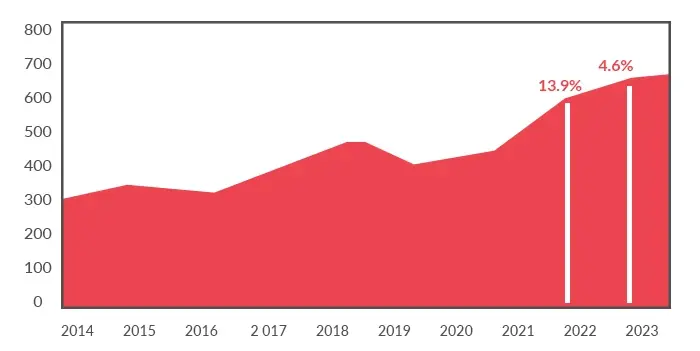
MacroFab Blog
Today’s business world is marked by a turbulent global landscape where resilience forms the foundation of any successful strategy. The market’s unpredictability, fueled by geopolitical changes, economic fluctuations, and the impact of climate change, has highlighted the critical need for robust business models capable of withstanding these instabilities. Diversification has emerged as a strategic pillar for enhancing resilience, particularly evident in the hardware technology sector, where diversification of offerings has bolstered both resilience and growth.
The Value of a Diversified Product Portfolio

This mission requires a detailed analysis of market trends, understanding consumer preferences, and keeping an eye on competitor actions. Such insights provide a roadmap for product innovation. Take Apple Inc., for instance. They achieved great success using a “related diversification” strategy, launching new products like the iPod and iPhone that were closely related to their existing product line. This diversification strategy highlights how the clever use of existing resources can propel a company’s growth and reach.
Looking at it this way, related diversification is a practical way to optimize the use of existing resources and capabilities while enlarging the spectrum of product offerings. Apple built on its reputation for user-friendly design and premium hardware to branch out from computers to smartphones and tablets. Similarly, Nvidia, a leading player in the graphics processing unit (GPU) market, tapped into its technological expertise to break into the data center market, offering GPUs for advanced artificial intelligence and machine learning applications.
Checkpoint
By diversifying target markets, electronics companies can expand their customer base, mitigate the risk of single-market reliance, and stimulate business growth.
Strategies like these depend heavily on a solid understanding of the company’s target market. If making industrial products, for example, companies need to understand the rate and method at which end-users are transitioning from traditional analog to digital systems. The right understanding of this will enable companies to diversify their product portfolios at the right pace and compete more effectively.
Companies can also engage in self-assessment, evaluating their current offerings and identifying opportunities to modify or enhance them to attract new customer segments or meet evolving needs. This strategic approach guides investment decisions and reduces the risk associated with product launches, enabling companies to maintain a competitive edge and prepare for sustained growth.
Diversification of Target Markets

Diversification extends beyond product offerings to encompass target markets. This involves identifying potential new markets for expansion, tailoring products and marketing strategies to suit different regions, and fostering partnerships to facilitate market entry.
Samsung is a successful example of market diversification in the electronics sector. The South Korean multinational has successfully penetrated various global markets, modifying its product line to meet each market’s needs. For instance, Samsung introduced affordable smartphones and other electronics in emerging markets like India and Africa, catering to price-sensitive demographics, thereby reinforcing its global dominance in the electronics industry.
The electronics industry has witnessed tremendous growth across diverse sectors and regions. According to World Semiconductor Trade Statistics, the global semiconductor market is projected to expand by 13.9 percent in 2022 and 4.6 percent in 2023. As demand for smarter, connected products escalates, businesses that diversify their target markets and adapt to regional preferences can seize new growth opportunities.


For successful market diversification, it’s essential to adapt products and marketing strategies to the nuances of various regions. This often involves adjusting aspects of the marketing mix, such as product design, pricing, promotional strategies, and distribution channels, to align with the dynamics of local markets and consumer behaviors.
Samsung Electronics has exemplified this approach, showcasing a dedication to understanding and fulfilling customers’ unique needs and wants in different regions. Samsung AddWash washing machine features a small door for adding items mid-cycle after studying Southeast Asian consumer needs. The innovative design earned several awards, solidifying Samsung’s position as the region’s preferred home appliance brand.
Furthermore, partnerships and alliances can assist in market entry. Many electronics firms collaborate with local retailers or strategically align with local firms to penetrate new markets. These partnerships can provide critical market insights and alleviate logistical challenges, accelerating market penetration and enhancing competitive positioning.
By diversifying target markets, electronics companies can expand their customer base, mitigate the risk of single-market reliance, and stimulate business growth. Therefore, integrating product and market diversification strategies can strengthen resilience in an unpredictable market landscape.
Conclusion

Diversification plays a crucial role in establishing resilience in the ever-evolving electronics industry. The necessity to innovate and adapt is more pronounced today than ever before, and the path to sustainable growth is paved with diversification strategies for both product offerings and target markets.
The stories of industry leaders such as Apple, Nvidia, and Samsung underscore the transformative power of diversification. By broadening their product lines and breaking into new markets, these companies have not only weathered global changes but also thrived, unlocking new growth avenues and expanding their customer base.
As we progress into an era where intelligent and connected products become commonplace, new market opportunities are constantly arising. Businesses that strategically diversify can seize these opportunities and gain a competitive edge. In volatile times, diversification serves as a lifeline and a potent catalyst for growth.
Related Topics
The Electronics Industry’s Need for Diverse Supply Chains
Electronics companies that diversify their suppliers, sourcing locales, and manufacturing sites bolster their defenses against potential disruptions.
Why Do Hardware Startups Fail?
An analysis of data reveals key factors contributing to the failure of hardware startups.
5 Things High-Performing Electronics Teams Do Differently
Optimal team performance in the electronics industry is essential, and clear communication is the cornerstone in new electronics development.
Let Us Solve Your Electronics Problems
Get a Quote NowAbout MacroFab
MacroFab offers comprehensive manufacturing solutions, from your smallest prototyping orders to your largest production needs. Our factory network locations are strategically located across North America, ensuring that we have the flexibility to provide capacity when and where you need it most.
Experience the future of EMS manufacturing with our state-of-the-art technology platform and cutting-edge digital supply chain solutions. At MacroFab, we ensure that your electronics are produced faster, more efficiently, and with fewer logistic problems than ever before.
Take advantage of AI-enabled sourcing opportunities and employ expert teams who are connected through a user-friendly technology platform. Discover how streamlined electronics manufacturing can benefit your business by contacting us today.